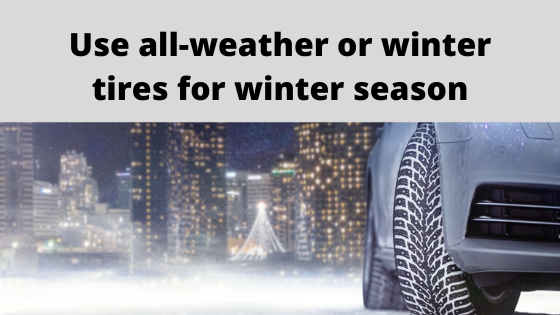After having installed dedicated winter tires in the winter you might wonder at what time you need to change back to regular car tires. This can be a little tricky as in some areas in the United States you might you might have a temporary warm up followed by freezing temperatures and snow fall. In general, when the temperatures stay consistently above 45 degrees Fahrenheit it is recommended to switch out of winter tires, either studded winter tires or non-studded winter tires.
If switching into all-season tires you should be aware that they perform better with temperatures above 45 degrees Fahrenheit whereas winter tires with their softer rubber compounds are made to be used in temperatures below 45 degrees Fahrenheit. If the weather where you live is to unpredictable and there is often a chance of temporary warming followed by true winter weather, you might want to consider equipping your car with all-weather tires eliminating the need entirely for winter tires. This is because the all-weather tires also hold the “Three Peak Mountain Snowflake” emblem signifying their approved use in severe winter conditions. Did you know that in severe winter conditions even when owning an SUV, tires with this emblem are recommended? This is because an SUV does not automatically handle better in winter conditions. In fact, the only benefit of an SUV is that the 4-wheel drive allows for better traction.
It is important to keep in mind the manufacturer’s recommended tire dimensions when buying a new set of tires. This means that if you are switching out of a 225/50R17 winter tires then you should change into 225/50R17 all-season tires. These markings give the width, aspect ratio and the diameter of the wheelbase with the “R” being for Radial construction. The correct tire dimensions assure the best handling of your car along with the best fuel economy.
Winter tires are usually made of rubber compounds that remain flexible and soft even in very cold winter temperatures however when the temperatures are above 45 degrees Fahrenheit, they start to they get hotter and hotter and eventually start to chemically degrade. This chemical degradation can actually cause the outside of the tire to become somewhat greasy and even decrease the gripping of the road, making it difficult to brake and increasing stopping distance. The rubber on all-season tires on the other hand is made to withstand heat. All-season tires have special rubber compounds that stays flexible yet firm to handle warmer temperatures so not to wear down as fast while providing proper traction in a variety of driving conditions from spring through fall.
It is recommended to switch out of winter tires (studded or non-studded) when temperatures stay consistently above 45 degrees Fahrenheit. If the weather is unpredictable where you live, then you might consider all-weather tires in the future which can be used all year around even in areas of severe winter weather due to their severe service emblem.
For more information regarding all-season tires for SUVs, visit: nokiantires.com
